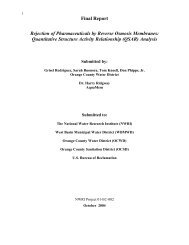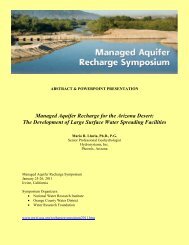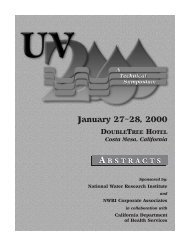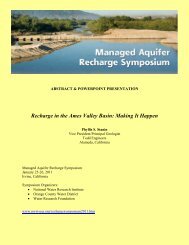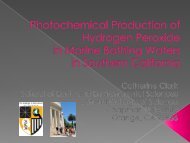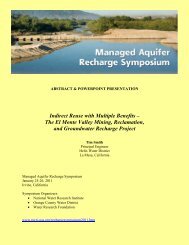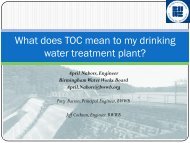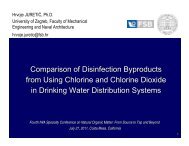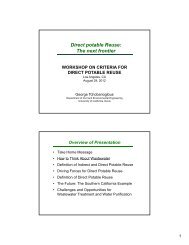Presentation
Presentation
Presentation
You also want an ePaper? Increase the reach of your titles
YUMPU automatically turns print PDFs into web optimized ePapers that Google loves.
Effect of Biological Activated Carbon Filters<br />
on the Removal of Biodegradable NOM and<br />
Molecular Weight<br />
Kerry Black, B.A.Sc, M.A.Sc.<br />
Dr. Pierre R. Bérubé, PhD, P.Eng.<br />
Vancouver, BC<br />
kerryb@interchange.ubc.ca<br />
Fourth IWA Specialty Conference on Natural Organic Matter<br />
July 27 – 29, 2011
Fourth IWA Specialty Conference on Natural Organic Matter:<br />
From Source to Tap and Beyond<br />
Natural Organic Matter (NOM) is a complex mixture<br />
of organic materials (e.g. humic substances) present<br />
in natural waters 1 .<br />
Chlorine disinfection has been shown to form potential<br />
carcinogenic compounds labelled disinfection by-products<br />
(DBPs)<br />
Disinfection By-Products have been of increasing concern and<br />
are now regulated by governing bodies (USEPA, Health<br />
Canada).<br />
Conventional treatment processes may not be capable of<br />
meeting current and future water quality guidelines 1 .
Fourth IWA Specialty Conference on Natural Organic Matter:<br />
From Source to Tap and Beyond<br />
Integrated treatment processes that combine<br />
oxidation processes and activated carbon biofilters<br />
have been shown to be very effective at reducing<br />
natural organic matter (NOM) levels 1, 2, 3 .<br />
Oxidation Processes<br />
Biofiltration<br />
• Increased concentration<br />
Biodegradable Organic Matter<br />
(BOM)<br />
• Removal of BOM, measured as<br />
Biodegradable Dissolved<br />
Organic Carbon (BDOC)
Fourth IWA Specialty Conference on Natural Organic Matter:<br />
From Source to Tap and Beyond<br />
Ozone is a strong oxidant. Typical ozone doses result in 4 :<br />
• Small destruction of TOC<br />
• Increased polarity & decreased aromaticity<br />
• Shift from HMW to LMW<br />
Leads to an increase in the biodegradability of TOC after<br />
ozonation.<br />
Disinfection<br />
• Only enough to inactivate<br />
organisms<br />
• Formation of BOM is undesirable<br />
Reduction of DBPs<br />
• Maximize production of BOM for<br />
removal by biofiltration
Fourth IWA Specialty Conference on Natural Organic Matter:<br />
From Source to Tap and Beyond<br />
Advanced Oxidation Processes (AOPs)<br />
Oxidation processes that generate hydroxyl free<br />
radicals (•OH)<br />
Non-selective oxidant that quickly oxidizes most<br />
organic compounds (e.g. aromatic hydrocarbons) 5<br />
Many types of AOPs UV/H 2 O 2<br />
UV photolysis: H 2 O 2 molecules produce •OH radicals<br />
H 2 O 2 + Σhν<br />
2 •OH
Fourth IWA Specialty Conference on Natural Organic Matter:<br />
From Source to Tap and Beyond<br />
Biofiltration is a critical part of this integrated process:<br />
• Key purpose is to remove BDOC formed during<br />
oxidation, thereby reducing DBPFP & potential regrowth<br />
• Insufficient or inadequate bacterial growth within the<br />
filter leads to 1,4 :<br />
• Incomplete removal of biodegradable organic matter<br />
• Increased potential of DBP formation<br />
• Production of biologically unstable water<br />
Implications on treatment efficiency &<br />
distribution system health
Fourth IWA Specialty Conference on Natural Organic Matter:<br />
From Source to Tap and Beyond<br />
Oxidation processes lead to the formation of biodegradable<br />
dissolved organic carbon (BDOC)<br />
Studies show that there are three forms of BDOC 1,2,5,6<br />
WHY?<br />
Rapidly biodegradable (BDOC r )<br />
Slowly biodegradable (BDOC s )<br />
Non-biodegradable<br />
• Rapidly Biodegradable Organic Carbon leads to the<br />
potential formation of DBPs<br />
• Slowly Biodegradable Organic Carbon leads to bacterial<br />
regrowth within the distribution system
Fourth IWA Specialty Conference on Natural Organic Matter:<br />
From Source to Tap and Beyond<br />
Determination of Biodegradable Fractions<br />
DOC (mg/L)<br />
Yavich et al, 2004
Fourth IWA Specialty Conference on Natural Organic Matter:<br />
From Source to Tap and Beyond<br />
Project focus:<br />
• Part 1 - Biofiltration Experiments: To assess the<br />
removal of NOM through biological activated<br />
carbon filtration.<br />
• To assess the impact of ozonation and<br />
biofiltration on source water quality including<br />
TOC, UVA, SUVA, AMW and DBPFP.<br />
• To acclimatize biomass in order to perform the<br />
biodegradation experiments in Part 2.
Fourth IWA Specialty Conference on Natural Organic Matter:<br />
From Source to Tap and Beyond<br />
Experimental Setup<br />
•Granular Activated Carbon<br />
Filters, Picabiol ®<br />
•Acclimatization over 5<br />
months with Ozonated water<br />
(2mgO 3 /mg DOC)<br />
Raw Water Characteristics:<br />
• 5 mg/L TOC<br />
• Alkalinity 50 mg/L as<br />
CaCO 3<br />
• Hardness, 50 mg/L as<br />
CaCO 3<br />
• Temperature 22°C<br />
• pH ~ 7
Fourth IWA Specialty Conference on Natural Organic Matter:<br />
From Source to Tap and Beyond<br />
Project focus:<br />
• Part 2 - Biodegradation Experiments: To assess the<br />
effect of oxidation on the rate of biodegradation.<br />
• To establish the effect of ozonation or UV/ H2O2 in<br />
combination with biological activated carbon filtration<br />
on the rate of biodegradation of organic matter and<br />
source water quality parameters including TOC, UVA,<br />
SUVA, AMW and DBPFP.<br />
• To develop a technique to evaluate biodegradation<br />
within activated carbon biofilters by determining the<br />
rate kinetics governing the removal of DOC over time.
Fourth IWA Specialty Conference on Natural Organic Matter:<br />
From Source to Tap and Beyond<br />
In series with filtration experiments, biodegradation tests<br />
were performed to determine removal of biodegradable<br />
organic carbon during oxidation and biofiltration.<br />
Harvest Acclimated<br />
Biomass<br />
Place in a Reactor<br />
with Treated Water<br />
Place in Shaker at<br />
22ºC for Various<br />
Times<br />
Measure DOC,<br />
SUVA, AMW<br />
4, 8, 12, 18 hrs; 1,<br />
2, 3, 4, 5, 6, 7 days<br />
Yavich et al,<br />
2004
Fourth IWA Specialty Conference on Natural Organic Matter:<br />
From Source to Tap and Beyond<br />
Source of<br />
Biomass<br />
Oxidant<br />
Dose<br />
Reaction<br />
Times<br />
BAC<br />
Column 1 &<br />
2<br />
None -<br />
Ozone<br />
1 mg/ mg DOC<br />
Ozone<br />
2 mg/ mg DOC<br />
Ozone<br />
Extended Dose<br />
(≈25 mg/mg DOC)<br />
AOP 2000 mJ/cm2 & 10 mg/L H 2 O 2<br />
AOP 4000 mJ/cm2 & 10 mg/L H 2 O 2<br />
AOP 4000 mJ/cm2 & 0 mg/L H 2 O 2<br />
4, 8, 12,<br />
18 hrs; 1,<br />
2, 3, 4, 5,<br />
6, 7 days
RESULTS
Fourth IWA Specialty Conference on Natural Organic Matter:<br />
From Source to Tap and Beyond<br />
Part 2 - Effect of Oxidation on DOC<br />
6<br />
5<br />
0<br />
-3% -3%<br />
-13%<br />
4<br />
3<br />
2<br />
DOC (mg/L)<br />
-38%<br />
-44%<br />
-60%<br />
1<br />
0<br />
Raw<br />
Ozonated Ozonated<br />
1mg/mg DOC2mg/mg DOC<br />
Ozonated<br />
Extended<br />
Dose<br />
UV<br />
4000mJ/cm2<br />
& 0mg/L<br />
H2O2<br />
UV<br />
2000mJ/cm2<br />
& 10mg/L<br />
H2O2<br />
UV<br />
4000mJ/cm2<br />
& 10mg/L<br />
H2O2
Fourth IWA Specialty Conference on Natural Organic Matter:<br />
From Source to Tap and Beyond<br />
Part 2 - Effect of Oxidation on UVA<br />
3.5<br />
3<br />
2.5<br />
2<br />
1.5<br />
1<br />
0.5<br />
0<br />
Specific UV Absorbance (SUVA)<br />
0<br />
Raw<br />
0<br />
-18%<br />
-15%<br />
Ozonated<br />
1mg/mg<br />
DOC<br />
-30%<br />
Ozonated<br />
2mg/mg<br />
DOC<br />
-28%<br />
-65%<br />
-79%<br />
Ozonated<br />
Extended<br />
Dose<br />
-7%<br />
-19%<br />
UV<br />
4000mJ/cm2<br />
& 0mg/L<br />
H2O2<br />
SUVA<br />
UVA<br />
-45%<br />
-70%<br />
UV<br />
2000mJ/cm2<br />
& 10mg/L<br />
H2O2<br />
-51%<br />
UV Absorbance (UVA)<br />
-81%<br />
UV<br />
4000mJ/cm2<br />
& 10mg/L<br />
H2O2<br />
0.18<br />
0.16<br />
0.14<br />
0.12<br />
0.1<br />
0.08<br />
0.06<br />
0.04<br />
0.02<br />
0
Area Count<br />
0.25<br />
Fourth IWA Specialty Conference on Natural Organic Matter:<br />
From Source to Tap and Beyond<br />
Part 2 - Effect of Oxidation on AMW<br />
0.2<br />
0.15<br />
0.1<br />
0.05<br />
0<br />
0<br />
-45<br />
0<br />
-24<br />
-55-47<br />
-37<br />
0<br />
-11<br />
-22<br />
-52 -52 -35 0 4<br />
-7<br />
-23 -50<br />
-70<br />
-81 -61<br />
-80<br />
-67<br />
-78<br />
-95 -92 -94 -90 -85<br />
-86<br />
-98 -100 -99 -97 -96<br />
> 1350<br />
(F1)<br />
1050 - 1350<br />
(F2)<br />
750 - 1050<br />
(F3)<br />
0<br />
-8<br />
-8<br />
500 - 750<br />
(F4)<br />
Molecular Weight (Da)<br />
Raw Water<br />
4000 mJ/cm2 & 0mg/L H2O2<br />
2000 mJ/cm2 & 10mg/L H2O2<br />
4000 mJ/cm2 & 10mg/L H2O2<br />
1 mgO3/mg DOC<br />
2 mgO3/mg DOC<br />
Extended Ozonation<br />
300 - 500<br />
(F5)<br />
0<br />
10<br />
< 300<br />
(F6)<br />
19<br />
-2
Fourth IWA Specialty Conference on Natural Organic Matter:<br />
From Source to Tap and Beyond<br />
600<br />
500<br />
400<br />
300<br />
200<br />
100<br />
0<br />
Part 2 - Effect of Oxidation on DBPFP<br />
Concentration<br />
(ug/L)<br />
0<br />
Raw<br />
0<br />
-5<br />
22<br />
4000 mJ/cm2<br />
& 0 mg/L<br />
H2O2<br />
-16<br />
-28<br />
2000 mJ/cm2<br />
& 10 mg/L<br />
H2O2<br />
-45<br />
-50<br />
4000 mJ/cm2<br />
& 10 mg/L<br />
H2O2<br />
-6<br />
THM4 FP<br />
HAA9 FP<br />
-5<br />
Ozonated<br />
(1mg O3/mg<br />
DOC)<br />
-44<br />
-45<br />
Ozonated<br />
(2mg O3/mg<br />
DOC)<br />
-64<br />
-92<br />
Extended<br />
Ozonation<br />
(25mg O3/mg<br />
DOC)
2.5<br />
2<br />
1.5<br />
Fourth IWA Specialty Conference on Natural Organic Matter:<br />
From Source to Tap and Beyond<br />
Part 2 - Effect of Biodegradation on NOM<br />
y = a +bexp(-<br />
cx)<br />
Generated Curve Fit<br />
95% Confidence Interval<br />
95% Confidence Interval<br />
Actual Data<br />
DOC (mg/L)<br />
1<br />
0.5<br />
0<br />
0 2 4 6 8<br />
Time (Days)
Fourth IWA Specialty Conference on Natural Organic Matter:<br />
From Source to Tap and Beyond<br />
DOC (mg/L)<br />
6<br />
5<br />
4<br />
3<br />
2<br />
1<br />
0<br />
Curve 17.0<br />
BAC Column 1<br />
Generated Curve Fit<br />
90% Confidence Interval<br />
90% Confidence Interval<br />
Actual Data<br />
0 1 2 3 4 5 6 7<br />
Time (Days)<br />
6<br />
5<br />
Curve 19.0<br />
BAC Column 1<br />
6<br />
5<br />
Curve 37.0<br />
BAC Column 1<br />
DOC (mg/L)<br />
4<br />
3<br />
2<br />
1<br />
0<br />
Generated Curve Fit<br />
90% Confidence Interval<br />
90% Confidence Interval<br />
Actual Data<br />
DOC (mg/L)<br />
4<br />
3<br />
2<br />
1<br />
0<br />
Generated Curve Fit<br />
90% Confidence Interval<br />
90% Confidence Interval<br />
Actual Data<br />
0 1 2 3 4 5 6 7<br />
Time (Days)<br />
0 1 2 3 4 5 6 7<br />
Time (Days)
Fourth IWA Specialty Conference on Natural Organic Matter:<br />
From Source to Tap and Beyond<br />
3.500<br />
3.000<br />
2.500<br />
2.000<br />
1.500<br />
1.000<br />
0.500<br />
Parameter a – DOCnon (mg/L) BAC Column 1<br />
0 -3<br />
0<br />
8<br />
-15<br />
-49<br />
-47<br />
-66 -60<br />
16<br />
11<br />
BAC Column 2<br />
2<br />
-67<br />
-73<br />
0.000<br />
Raw Water 4000<br />
mJ/cm2 &<br />
0 mg/L<br />
H2O2<br />
2000<br />
mJ/cm2 &<br />
10 mg/L<br />
H2O2<br />
4000<br />
mJ/cm2 &<br />
10 mg/L<br />
H2O2<br />
Ozonated<br />
(1mg<br />
O3/mg<br />
DOC)<br />
Ozonated<br />
(2mg<br />
O3/mg<br />
DOC)<br />
Extended<br />
Ozonation<br />
(25mg<br />
O3/mg<br />
DOC)
Fourth IWA Specialty Conference on Natural Organic Matter:<br />
From Source to Tap and Beyond<br />
3.500<br />
3.000<br />
2.500<br />
2.000<br />
1.500<br />
0<br />
Parameter c - Kinetic Rate Constant (k)<br />
40<br />
24<br />
0<br />
-6<br />
-14<br />
-24<br />
-20<br />
-12 -12<br />
-33<br />
BAC Column 1<br />
BAC Column 2<br />
-27<br />
1.000<br />
0.500<br />
-66<br />
-80<br />
0.000<br />
Raw Water 4000<br />
mJ/cm2 & 0<br />
mg/L H2O2<br />
2000<br />
mJ/cm2 &<br />
10 mg/L<br />
H2O2<br />
4000<br />
mJ/cm2 &<br />
10 mg/L<br />
H2O2<br />
Ozonated Ozonated<br />
(1mg O3/mg (2mg O3/mg<br />
DOC) DOC)<br />
Extended<br />
Ozonation<br />
(25mg<br />
O3/mg<br />
DOC)
Fourth IWA Specialty Conference on Natural Organic Matter:<br />
From Source to Tap and Beyond<br />
Response<br />
8.00E-03<br />
7.00E-03<br />
6.00E-03<br />
5.00E-03<br />
4.00E-03<br />
3.00E-03<br />
2.00E-03<br />
1.00E-03<br />
Raw<br />
Treated<br />
4 hours<br />
8 hours<br />
12 hours<br />
18 hours<br />
1 Day<br />
2 Days<br />
3 Days<br />
4 Days<br />
5 Days<br />
6 Days<br />
7 Days<br />
0.00E+00<br />
-1.00E-03<br />
0.01 0.1 1 10 100<br />
MW [kDa]
Fourth IWA Specialty Conference on Natural Organic Matter:<br />
From Source to Tap and Beyond<br />
Part 2 - Effect of<br />
Biodegradation on NOM<br />
Area Count<br />
0.2<br />
0.18<br />
0.16<br />
0.14<br />
0.12<br />
0.1<br />
0.08<br />
0.06<br />
0.04<br />
0.02<br />
0<br />
ID 19 Ozone 2mg<br />
Column 1<br />
0 0<br />
0 0<br />
-42<br />
-41<br />
-45<br />
-44<br />
-52 -53 -55 -53<br />
-76 -73 -74 -72<br />
Raw<br />
Treated<br />
Time 1 Day<br />
Time 7 Days<br />
0<br />
-42<br />
-51<br />
-71<br />
0<br />
-33<br />
-46<br />
-71<br />
> 1350<br />
(F1)<br />
1050 - 1350<br />
(F2)<br />
750 - 1050 500 - 750<br />
(F3) (F4)<br />
Molecular Weight (Da)<br />
300 - 500<br />
(F5)<br />
< 300<br />
(F6)
Fourth IWA Specialty Conference on Natural Organic Matter:<br />
From Source to Tap and Beyond<br />
Part 1 Conclusions<br />
• Ozonation at 2 mg O 3 /mg DOC did not result in a significant<br />
reduction in DOC, but did have a significant effect on UVA &<br />
AMW.<br />
• DBPFP was significantly reduced following ozonation;<br />
However, overall ozonation was unable to lower DBPFP below<br />
the Canadian Drinking Water Guideline values.<br />
• Subsequent biofiltration resulted in significant reduction in<br />
DOC levels.<br />
• BAC Column 1 preferentially biodegraded the smaller<br />
molecular weight NOM that was more biodegradable.<br />
• Only BAC Column 2 was able to lower the DBPFP and<br />
generate THM and HAA concentrations that were below the<br />
Health Canada Canadian Drinking Water Guideline values.
Fourth IWA Specialty Conference on Natural Organic Matter:<br />
From Source to Tap and Beyond<br />
Part 2 Conclusions<br />
• High dose oxidation is required to lower DOC levels<br />
significantly.<br />
• High dose ozonation & UV/H2O2 was successful at<br />
significantly lowering the fraction and amount of aromatic<br />
material present in feed water.<br />
• Ozonation at 2mg O3/mg DOC and UV/H2O2 treatment at<br />
2000mJ/cm2 and 10 mg/L resulted in a shift from high AMW to<br />
low AMW NOM. This effect was not as noticeable for the<br />
higher ozonation and AOP doses.<br />
• Only the extended ozonation dose of 25 mgO3/mg DOC was<br />
able to meet the Canadian Drinking Water Guideline limits for<br />
THMs and HAAs.
Fourth IWA Specialty Conference on Natural Organic Matter:<br />
From Source to Tap and Beyond<br />
Part 2 Conclusions<br />
• Results suggest that the amount of non-biodegradable DOC is<br />
a function of the type and dose of oxidant used.<br />
• With the exception of the ozonation at 25mgO3/mg DOC,<br />
kDOC was not a function of the type or dose of oxidant used.<br />
• Very little biodegradation occurred at the high dose UV/H2O2<br />
and extended ozonation doses – in contrast to the lower<br />
doses.<br />
• Results suggest that lower AMW NOM is preferentially<br />
biodegraded during biofiltration.<br />
• Biomass from BAC Column 1 and BAC Column 2 resulted in<br />
similar biodegradation kinetics
Fourth IWA Specialty Conference on Natural Organic Matter:<br />
From Source to Tap and Beyond<br />
THANK YOU!<br />
kerryb@interchange.ubc.ca<br />
1) Yavich, A.A., Lee, K.H., Chen, K.C., Pape, L. & Masten, S.J. (2004). Evaluation of biodegradability of NOM after<br />
ozonation. Water Research. 38 (12) pp. 2839 - 2846.<br />
2) Health Canada. (2008). Guidelines for Canadian Drinking Water Quality. Federal-Provincial-Territorial Committee on<br />
Drinking Water. May, 2008. Available at http://www.hc-sc.gc.ca/ewh-semt/alt_formats/hecs-sesc/pdf/pubs/watereau/sum_guide-res_recom/summary-sommaire-eng.pdf<br />
3) Cipparone L.A., Diehl A.C. & Speitel, Jr. G.E. (2007). Ozonation and BDOC removal: effect on water quality. J. Am.<br />
Water Works Assoc. 89 2 (1997), pp. 84–97.<br />
4) Carlson, K.H. & Amy, G.L. (1997). The Formation of Filter-Removable Biodegradable Organic Matter During<br />
Ozonation. Ozone: Science & Engineering. 19(2) pp 179-199.<br />
5) Speitel, G.E., Wanielista, M.M., Symons, J.M. , Davis, J.M. (1999). Advanced Oxidation and Biodegradation<br />
Processes for the Destruction of TOC and DBP Precursors. AWWARF, 90758. 138p.<br />
6) Klevens, C.M., Collins, M.R., Negm, R., Farrar, M.F. & Fulton, G.P. Natural Organic Matter characterization and<br />
treatability by biological activated carbon filtration. In: Disinfection by-products and NOM precursors: chemistry,<br />
characterization, control; proceedings, ACS Symposium, 1996, Washington DC, p. 211-246.



